Breaking into the music industry via social media is nothing new. Justin Beiber found his beginnings on YouTube. Shawn Mendes posted a cover of a Justin Bieber song on the now-defunct app, Vine. More recently, Lil Nas X jumped on the TikTok bandwagon in 2018 and created a viral challenge to the song, “Old Town Road”.
With platforms like TikTok, it’s more likely to spread your digital content to a larger audience. As a musician, you want to share your craft with the world, and the far-reaching effects of social media and online platforms can be a great catalyst to do so. Learn how to utilize digital content effectively to boost your music career and promote your passion.
Getting Started
When contemplating starting or boosting your digital presence, you may wonder whether it’s absolutely necessary to build a following as a musician. Some creative types may find it overwhelming to feel as though they must produce digital content and share their art with unfamiliar people. Others may thrive when sharing their music online. Some may be able to quell their social anxiety about sharing music with the understanding that they’re doing what’s best for their career.
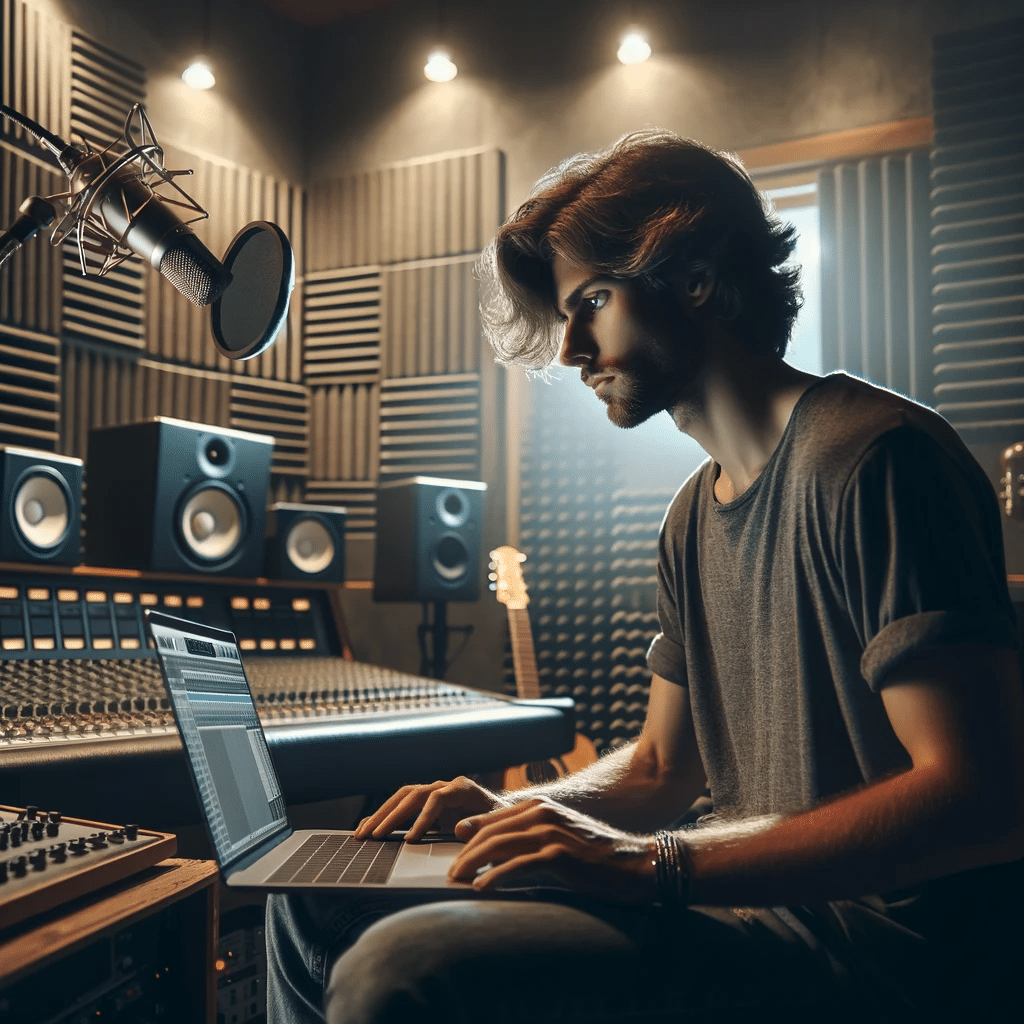
Determine Your Goals
The way to determine if creating digital content to share online is right for you is to delineate your personal music goals. Consider whether or not you want to:
- Put a significant amount of effort into self-promotion;
- Amass a large following;
- Be signed by a record label;
- Produce music independently;
- Tour nationally or internationally;
- Collaborate with brands and other creators/artists;
- Deal with constant feedback, positive and negative.
If you release your music for others to consume, it will naturally receive both praise and criticism. If your goals are just to create music for yourself or a small community of people, a large online presence might not be the right path for you. However, becoming a digital content creator can propel your career to reach new heights if that is what you are looking to accomplish.
Pinpoint Your Identity and Target Audience
If you’re an aspiring artist looking to kickstart your journey or an established musician seeking new avenues for growth, you can certainly benefit from an online presence. If you’ve decided this is the right path for you, it’s time to determine your unique brand identity. Before creating accounts or posting, make sure you are crystal clear on your niche.
This includes your genre, aesthetics, personality, and target audience. Defining your brand identity as a musician is like crafting your musical fingerprint. It’s about distilling your music, persona, and message into a cohesive narrative that resonates with a subset of people online and distinguishes you from the crowd. Your brand identity encompasses not only your musical style but also your image, values, and the emotions your music evokes.
This decision will influence the story you tell, the visuals you project, and the way you interact with your audience. By clarifying your online identity as an artist, you can build a stronger connection, attract like-minded supporters, and create a lasting impression that sets you apart in the ever-evolving music industry. This isn’t to say that you can’t evolve as an artist – but defining how you want to be perceived is important to kickstart your digital creation.
Choosing the Right Platforms
Deciding the right platforms through which to promote your music is a pivotal decision that can greatly impact your reach and success. To make an informed choice, start by researching where your ideal listener spends their time online. Figure out what platforms resonate with their music preferences, even looking at similar artists’ online personas for inspiration.
Additionally, consider your own strengths and resources. If you excel at creating visually engaging content, platforms like Instagram and TikTok may be ideal. Musicians leaning towards long-form storytelling and deeper connections may find success on YouTube or Facebook. It’s possible to make money from your passion on digital platforms, so make sure you are set up to do so. Patreon, Google Adsense, and other paid services can be integrated into your digital strategy later down the line when you accumulate some followers.
Remember, it’s not about being on every platform, but rather, selecting the ones that align with your music and brand. Pick one or two places where you can consistently engage and connect with your audience. This will maximize your promotional efforts and help you build a dedicated fanbase that will click through to your personal website, follow you on other platforms, or stream your music on Spotify and iTunes.
Using the Right Tools
When posting, make sure to focus on using tools that let your music shine. You can use audio recording and editing tools such as quality microphones and software to fine-tune how you present your music online. Whether you produce songs for other artists, work with producers for your songs, or produce independently, it’s important to pick applications that will put your best foot forward.
Crafting Engaging Content that Aligns with Your Music
The end goal of creating a digital presence as a musician is to garner followers who appreciate your craft. Consumers are more likely to engage with personalized content that is easy to digest, so the more engaging and personal you can make your content, the better.
At the end of the day, you are passionate about your career and want to share that with the world. Remember to keep your morals and values at the forefront of your online presence, keeping a cool head when faced with negativity or even unbridled fame that could happen seemingly overnight. Your followers will take note and be more loyal to you as a musician if you are transparent and consistent. The world of online promotion is tricky, but it can be a powerful tool to extend the reach of your music and propel you forward.
Is it Time to Buy a Touring Vehicle?So, you’ve decided to get on the road and start touring with your up-and-coming band. That’s great because playing live music is one of the best ways to make money and get your name out there. However, before booking your shows, you must iron out a few details. In addition to learning how you’ll maintain your mental and physical health during the tour, you’ll need to decide how you’ll get to each show. It may be time to consider renting or buying a touring vehicle.
If you’re at this stage in your career, weigh the pros and cons and research to make the best decision possible.
Pros And Cons of Owning A Touring Vehicle
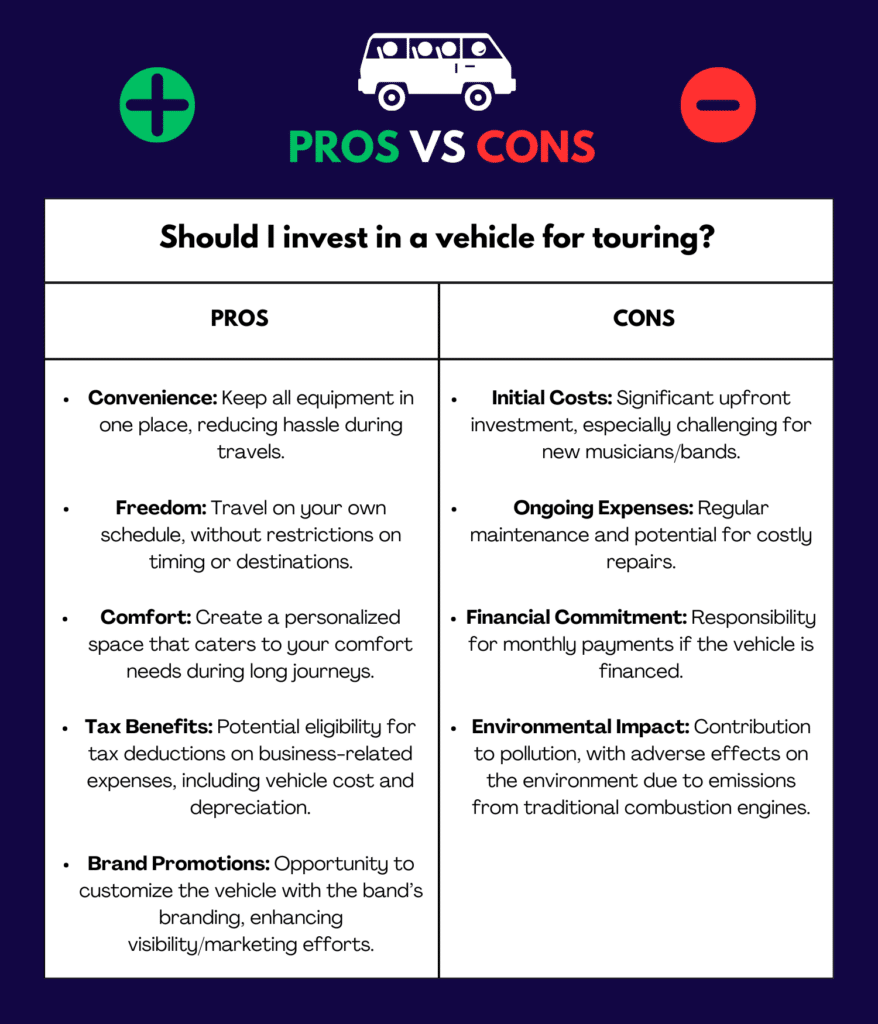
Before you head to the local dealership, it’s wise to look at the pros and cons of owning a vehicle. There are various perks to consider, including the fact that if you buy a van or bus, you’ll be able to keep all of your equipment in one place, so there’s less hassle. Plus, you can travel on your own terms and be comfortable along the way.
Since you’re technically a self-employed worker, as a musician, you may also be eligible for various tax benefits, including deducting your musical instruments and business expenses. Since you use it for touring, you may also be able to write off the cost and depreciation of your van as you use it over the years.
Like with almost any purchase, there can be potential downsides to buying your vehicle. Among them is the fact that you’ll be on the hook for payments, which may be tough if you’re just starting to make money as a musician. Since you’ll be driving it a lot, you’ll also need to maintain the vehicle regularly by filling the tires, changing the oil, and checking the fluids, which can take time and money.
There are also environmental impacts of vehicle ownership. Internal combustion vehicles create carbon pollution. In addition to hurting the environment, pollution also affects your health. The pollutants in the air can cause eye, nose, and throat irritation over time, which can make it hard to breathe. The condition will only worsen if you already have asthma or respiratory issues. Plus, the chemicals in pollution can increase the chance of cancer.
You’ll want to weigh all of these pros and cons and decide if you really need to buy a new vehicle or if you just want one.
Renting Vs. Owning
If you decide to get a vehicle, you next need to determine if you’ll rent or buy. There are some benefits to buying a new or used vehicle outright. When you buy a car, you’re the owner, and you can do with it as you wish. You can customize the vehicle’s side with your band’s logo if you want. Plus, you won’t have monthly mileage limits to worry about if you decide to add on another show at the last moment.
On the downside, the monthly payments will often be more expensive than the cost of a rental, and you may need to take out a loan that can have a high-interest rate. Once the warranty runs out, you’ll also be on the hook for maintenance costs, which can get expensive over time.
Depending on your situation, there are also benefits to renting instead of owning. In addition to a reduced cost to rent the vehicle, you’re not on the hook for repairs, especially if you don’t cause the damage yourself. You can also protect yourself by taking out short-term insurance. Best of all, when your tour ends, you can return the car and save money for the next rental. Renting can be a great solution if you don’t plan to be on the road year-round.
Choosing A Vehicle If You Decide To Buy
If you decide to purchase a touring vehicle after thinking long and hard, you need to sit down and do your research. First, consider the type of vehicle that’s best for your needs. Solo acts and small bands with only a few instruments may opt for a car or an SUV that provides plenty of room but doesn’t go overboard. Larger bands with numerous instruments may require a cargo van or a splitter van that provides separate spaces for personal items and the instruments.
Once you start narrowing down your choices, completing more extensive research is wise. Look at gas mileage and consider how often you may have to fill the tank. A larger vehicle may go through gas quickly, so consider if you need a van or can buy something smaller. Also, read reviews about the dependability and maintenance other owners face. Don’t forget to also think about the smaller details, like whether you can install a hitch if you need to haul a trailer.
Your research may lead you to buy a used car, which can be a good idea because they’ll often have lower payments. However, you must be careful because there are some red flags to beware of in used car listings. One of them is when the seller does not supply adequate pictures. If the listing only shows exterior or interior shots, you may need to wonder if the customer is hiding something. See the vehicle in person before you commit.
It’s also essential to carefully read the listing of your potential vehicle to ensure that you’re on the right track. Some sellers will type in many different car models into their vehicle descriptions in hopes of getting more clicks and what you see may not be what you’re looking for. Ensure you’re getting valid details before you pursue the sale any further.
Conclusion
Buying your first touring vehicle is incredibly exciting because it means that you’re finding success as a musician. However, don’t let the thrill cloud your judgment. Take the time to research and think about your needs and make the best choice from there.
How to Turn Your Music Into a Business OpportunityThe music industry can be a tough nut to crack. Gaining exposure and a loyal following is difficult without a big record label behind you and competition is stiff on platforms like Spotify and Soundcloud.
You’ll need a strategic, business-oriented mindset to distribute, market, and monetize your passion for music. A business-like approach will ensure your long-term financial security and help you make money sooner as a musician.
Starting a Small Business
Earning income from your musical talents can be deeply rewarding. However, from the moment you cash your first check, you need to start thinking of yourself as a small, growing business. This shift in mindset will help you embrace the entrepreneurial spirit and successfully navigate the basics of successful business ownership.
Avoid the most common mistakes for small businesses by outlining your operational goals, target market, financial plan, and marketing strategy before your brand starts to grow. This will help you accurately estimate your costs and ensure that you don’t end up with a budget in the red. This business plan should include key details like:
- Your area(s) of interest (live performer, music instructor, sound designer, etc.)
- Your business structure (Sole Proprietorship, Partnership, LLC, etc.)
- Long-Term Marketing Strategy
- Channels of distribution (e.g. what will your point of sale look like? How will you distribute music to producers?)
- Bookkeeping procedures (which accountants will you hire? How will you store and record your invoices?)
Seek help early and often during the start-up phase. Your working capital may be limited during the first months of your musical career, but professional help can make a huge difference to your long-term viability. Join local business organizations to increase the scope of your network and try to connect with a mentor who is well-established in the music industry.
Remember to reinvest some of your profits into skill development, too. You may be able to bus out Beethoven’s Sonata No. 9 on command, but what are your marketing skills like? Failing to invest in self-development will limit your long-term growth and undermine your ability to adapt to the ever-changing music market.
If you’re planning on recording and producing your own music, you should invest in a soundproof home recording studio. Installing a home recording studio ensures that you can ride the waves of creative inspiration when they come and will reduce your long-term costs. A great home studio can add serious value to your property, too, as soundproofed spaces are a rarity on the market.
Growing Your Brand
Your brand is a public reflection of your skills as a musician. Without a strong brand, consumers will turn to competitors who already have a track record in the industry.
Start small and focus on building a social media presence that impresses consumers, record labels, and potential investors alike. You can post clips from the most recent performances on your social media and should invest in a few photoshoots to give your page a “professional” image.
If you’re struggling to plan and produce social content, create a social media content calendar to alleviate the pressure to post. A monthly social calendar should utilize the social media rule of thirds:
- One-third of posts direct users to your point of sale
- One-third of posts should feature curated music-industry content
- One-third of posts should hinge on interacting and engaging with your followers
A rule of thirds approach will help you grow your brand at a minimal cost. As your brand starts to grow, consider investing in more paid marketing services. Hiring a professional social media account manager or a web designer can help build your brand and ensure that you continue to grow as a musician and a business person.

Financial Security
Running your own small business can give you financial freedom and personal pride. However, as your business grows, you make take on more risk than you first intended to. Working with an accountant or business manager who specializes in the music industry can help mitigate risk and secure your long-term finances. Watch the video below to learn tips on how to make your band a business.
You may want to register as an LLC as your business grows. The U.S. small business administration explains that LLCs “protect you from personal liability,” meaning your personal assets (like your car or home) won’t be at risk if your business fails. This makes LLCs a great choice for medium-risk enterprises in the music industry.
Minimize your risk of facing financial strains by diversifying your income streams as a musician. You may eventually want to make all of your earnings from sound design, but money-making endeavors like teaching music and composing for private commissions can be a great way to bolster your income.
Consider utilizing the subscription model as you gain more followers online. The subscription model can give you increased financial security as it provides a predictable income stream. This can be useful when budgeting, as you can rely on a steady income from your subscribers. Today, many musicians post on popular subscription-only sites like Patreon and Podia.
Conclusion
Turning your passion for music into a business opportunity can be daunting. However, with the right business structure and professional help, you can earn a great living from your pizzicatos and perfect pitch. Secure your long-term financial future by adopting a subscription model and choosing a business structure that works for you.
Demystifying the Noise Floor: Unraveling its Impact on Audio QualityIn the field of audio and signal processing, achieving excellent sound quality is essential. Whether you’re a musician, sound engineer, podcaster, or audio enthusiast, it’s helpful to understand the decibel noise floor. The noise floor acts as a reference point for assessing the quality and clarity of audio signals in different environments. By grasping the nuances of the noise floor and meeting its requirements, you can enhance the overall audio experience.
In this guide, we’ll explore the decibel noise floor and its definition, measurement, factors that influence it, strategies to meet it, and the role of equipment. By the end, you’ll have a solid understanding of this concept. You’ll be equipped with the knowledge to make informed decisions about audio recording, production, and playback.
So, let’s unravel the mysteries of the decibel noise floor and unlock the secrets to pristine sound quality.
1. Understanding the Decibel Noise Floor
To understand the decibel noise floor, it’s necessary to grasp the decibel (dB) scale. A decibel is a logarithmic unit used to express the ratio between two values, often associated with sound pressure levels. Its logarithmic nature helps us represent a wide range of values more easily.
The decibel scale is relative and often based on a baseline value. In audio, 0 dB is commonly used, representing the threshold of human hearing. Since the scale is logarithmic, a 10 dB increase means the sound intensity doubles, while a 10 dB decrease means it halves.
The image below helps illustrate the exponential curve of loudness. With 70 dB set as the comparison point, you can see how a (+/-) change in dB drastically affects perceived volume.
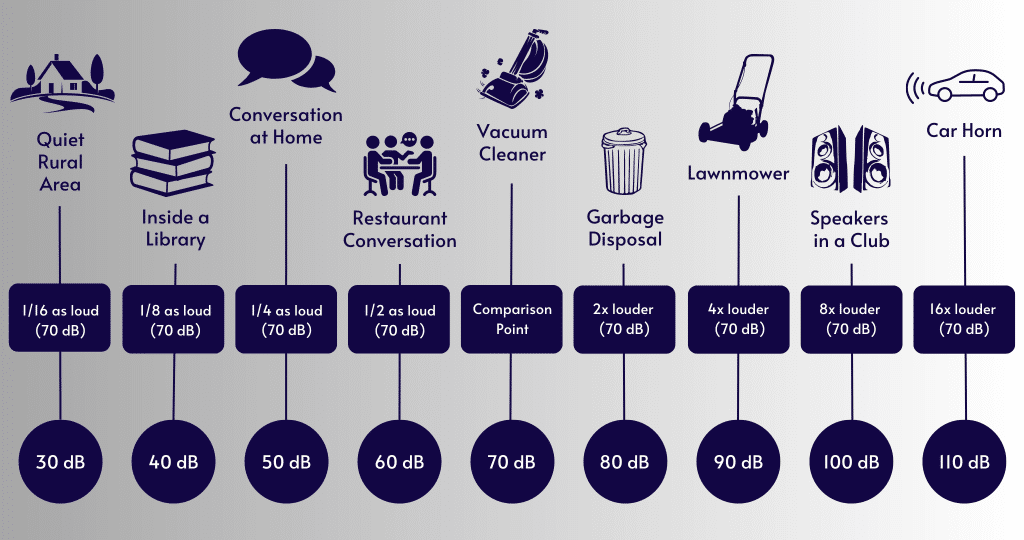
Definition of the Noise Floor
The noise floor refers to the level of unwanted background noise present in an audio or signal system when no significant signal is present. It is the baseline noise level that exists even in the absence of intentional sound sources. This noise is comprised of various factors, such as electrical interference, thermal noise, hardware/software settings, and environmental sound.
Role of the Noise Floor in Audio and Signal Processing
The noise floor plays a significant role in audio and signal processing systems. It sets a lower limit on the detectable and usable signals within a given system. Ideally, a low noise floor minimizes unwanted noise and preserves audio quality, dynamic range, and signal fidelity.
Differentiating Between Signal and Noise
In the context of the decibel noise floor, it’s important to differentiate between the signal and noise components. The signal represent the desired audio or information that needs to be captured or processed, while noise refers to any unwanted disturbances that interfere with the signal.
The signal-to-noise ratio (SNR) is often used to express the relationship between the desired signal and the noise floor. A higher SNR indicates a stronger, more distinguishable signal relative to the noise floor, resulting in better audio quality.
Understanding the distinction between signal and noise helps to optimize audio systems and ensure high-quality sound reproduction.
Sound level meters are commonly used tools for measuring and quantifying the noise floor. These devices consist of a microphone, preamplifier, and signal-processing circuitry to analyze sound pressure levels. Some sound engineers rely on them to assess the noise floor’s impact on sound quality.
However, when working in a digital audio workstation (DAW), analyzing the noise floor becomes more precise. DAWs offer tools and plugins for accurate noise reduction and spectral analysis. With a DAW, audio professionals can measure the noise floor and make targeted adjustments to enhance sound quality and minimize unwanted noise.
3. Factors Affecting the Noise Floor
The noise floor can be affected by environmental factors, including ambient noise. In recording environments, external sounds like traffic, HVAC systems, or nearby construction make an impact. Likewise, in live sound settings, the venue’s ambient noise level influences the noise floor.
Minimizing these environmental noises through proper soundproofing, acoustic treatment, and strategic placement of microphones can help reduce the impact on the noise floor.
Analog Audio Equipment
Analog audio equipment like preamplifiers, mixers, amps, and synthesizers can introduce noise into the signal chain. This noise originates from components such as transformers, transistors, and resistors. Factors like equipment age, component quality, grounding schemes, and shielding influence the noise floor produced by analog equipment.
High-quality equipment, proper maintenance, and attention to grounding and shielding practices can help minimize equipment-generated noise.
Digital Audio Equipment
Although digital audio systems have low inherent noise, they can still introduce unwanted sound due to clocking issues, power supply noise, and digital processing artifacts. For example, poorly designed analog-to-digital converters (ADCs) or digital-to-analog converters (DACs) can contribute to a higher noise floor.
Selecting high-quality digital audio equipment and following best practices in signal processing helps maintain an optimal level.
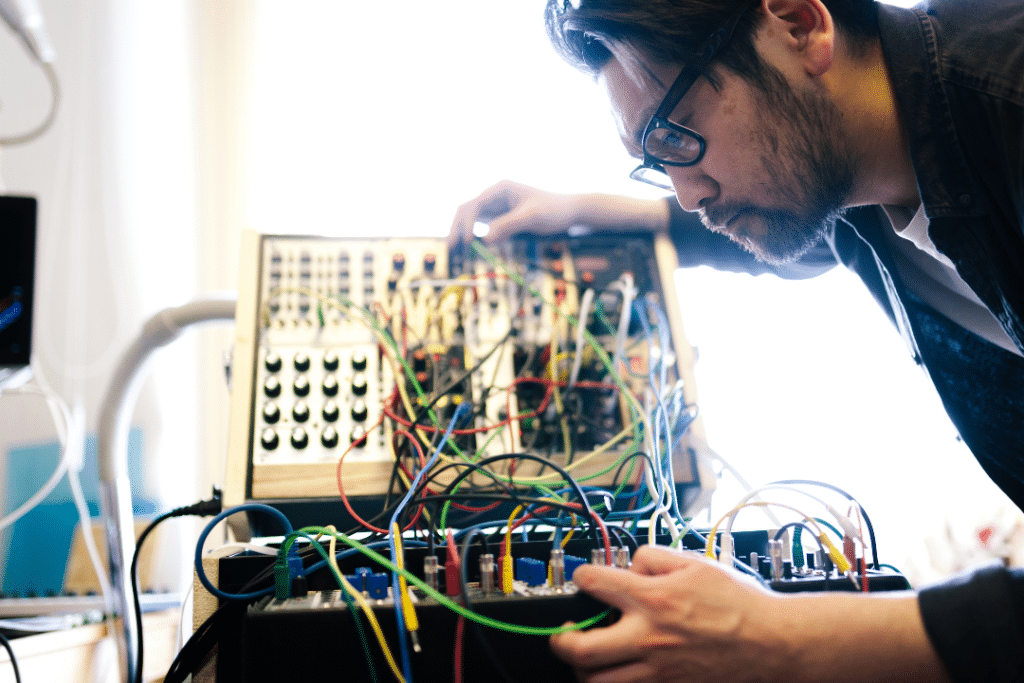
Signal Chain and Noise Floor Interaction
The entire audio signal chain, from source to output, affects the noise floor. Components like microphones, preamps, processors, and speakers can introduce noise that accumulates along the path. To achieve a low noise floor level, consider component noise characteristics and ensure compatibility. Proper gain staging and signal level management minimize noise floor accumulation, resulting in cleaner audio signals.
Understanding and addressing these factors, be it environmental issues, equipment-generated noise, or the interaction within the signal chain, is essential for maintaining optimal audio quality and reducing unwanted noise in audio production and performance scenarios.
4. Strategies for Meeting the Noise Floor
Implementing noise reduction techniques and following best practices are essential for meeting your required noise floor. Some effective strategies include:
- Proper microphone placement: Position the microphone close to the sound source while minimizing background noise pickup.
- Acoustic treatment: Using sound-absorbing materials, such as acoustic panels or bass traps, to reduce reflections and reverberations in recording spaces.
- Noise gates: Employing noise gates to automatically mute or attenuate signals below a certain threshold, effectively eliminating low-level noise during pauses or quieter sections.
- Noise reduction plugins: Utilizing software plugins or hardware processors designed to reduce specific types of noise, such as hiss, hum, or broadband noise.
- Editing and spectral repair: Employing precise editing techniques and spectral repair tools in DAWs to remove or attenuate unwanted noise from audio recordings.
- Soundproofing: Implementing soundproofing techniques, such as using double walls, acoustic insulation, and isolation enclosures (such as a WhisperRoom), to minimize external noise from entering the recording space.
Importance of Proper Equipment Selection and Maintenance
Choosing the right equipment and ensuring its proper maintenance will help you meet the noise floor. Consider the following:
- High-quality microphones: Select microphones with low self-noise and suitable polar patterns for the desired application.
- Low-noise preamps: Using preamplifiers with low noise figures and excellent signal-to-noise ratios.
- Quality cables and connectors: Opt for well-shielded cables and connectors that minimize interference and signal degradation.
- Regular equipment maintenance: Cleaning and inspecting equipment regularly to identify and rectify any potential noise-related issues.
Shielding and Grounding to Minimize Electromagnetic Interference
To minimize the impact of electromagnetic interference (EMI), shielding and grounding techniques are important. Proper grounding of all equipment helps minimize ground loops, which can cause hum and interference. Additionally, using shielded cables for audio connections reduces the impact of EMI.
Noise Floor Optimization in Recording, Broadcasting, and Live Sound Scenarios
Meeting the noise floor requirements differs across audio applications. In recording scenarios, it involves creating a controlled, quiet environment. Selecting suitable microphones and preamps, and implementing noise-reduction techniques during editing and mixing stages are also important.
Broadcasting requires minimizing background noise during live broadcasts, utilizing noise reduction technologies, and incorporating effective soundproofing and acoustic treatment in studio spaces.
In live sound settings, selecting low-noise equipment, optimizing gain staging, implementing sound reinforcement techniques, and managing ambient noise levels in the venue is necessary for achieving a low noise floor.
5. Equipment’s Role in the Noise Floor
In audio production, various equipment components play a big role, from microphones and preamps to digital audio converters and cables. Understanding the impact of each element is important for achieving an optimal noise floor and maintaining pristine audio quality.
Microphones and Their Noise Characteristics
Microphones are a paramount component for capturing audio signals, and their noise characteristics can significantly impact the noise floor. Different types of microphones have varying levels of self-noise. For example, condenser microphones generally have lower self-noise than dynamic microphones. When choosing microphones, consider noise specifications like self-noise level and signal-to-noise ratio to minimize their contribution to the overall noise floor.
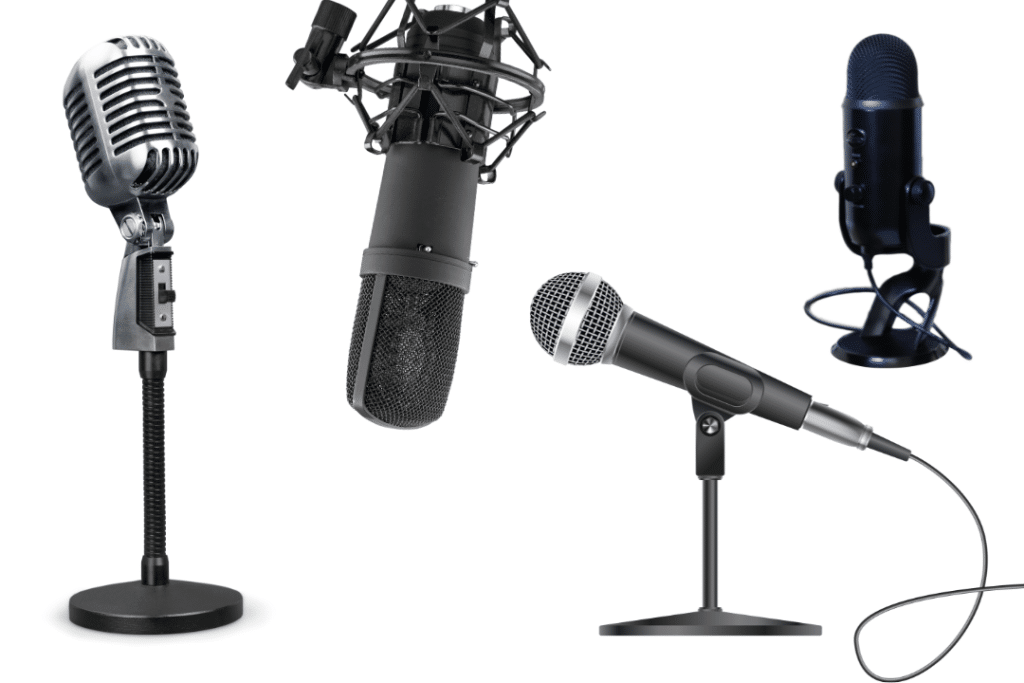
Preamps, Mixers, and Their Impact on the Noise Floor
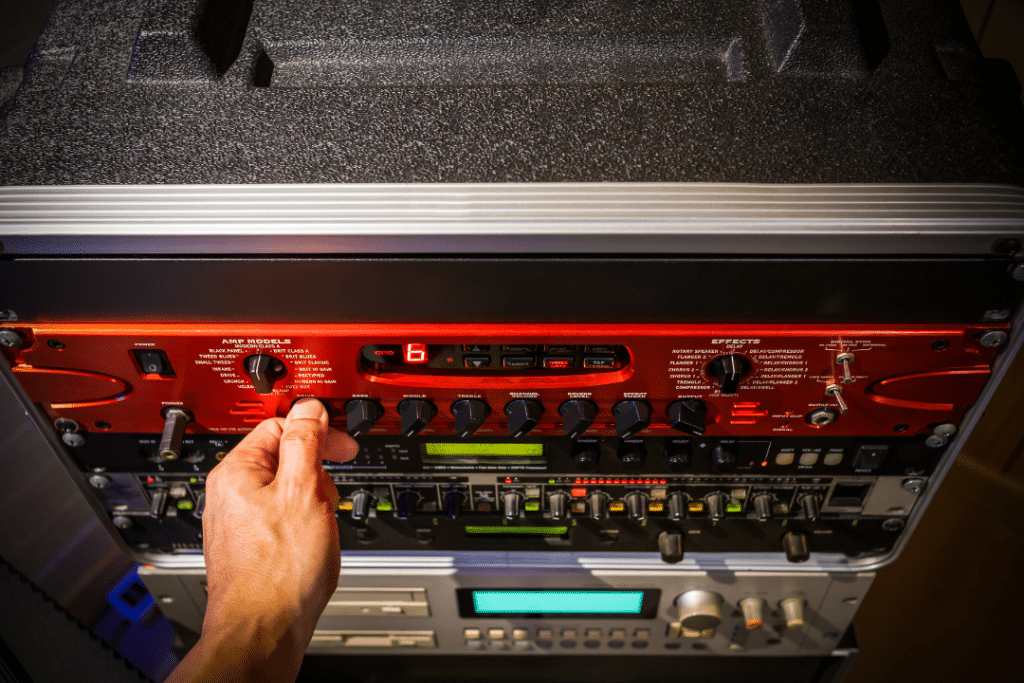
Preamps and mixers are essential parts of audio systems, and their quality can impact the noise floor. Preamps amplify microphone or instrument signals to line level, but low-quality ones may introduce additional noise.
Similarly, mixers can contribute to the noise if they have loud circuitry or inadequate signal-to-noise ratios. Choosing high-quality preamps and mixers with low-noise figures is imperative for maintaining a low noise floor.
Digital Audio Converters and Noise Floor Considerations
Digital audio converters (DACs and ADCs) are responsible for converting analog audio signals to digital and vice versa. During this conversion process, they may introduce noise into the audio signal. The noise floor of digital audio converters depends on factors like design quality, resolution, bit depth, and clocking system. High-quality digital audio converters with excellent dynamic range and low distortion help achieve a lower noise floor in digital audio workflows.
Cables and Connectors as Potential Sources of Noise
Cables and connectors play a vital role in audio signal transmission, but poor-quality or poorly shielded ones can introduce noise. Low-quality cables and connectors may pick up electromagnetic interference (EMI) or radio frequency interference (RFI), which can add noise to the signal chain. Using high-quality, well-shielded cables and connectors reduces the risk of noise interference, ensuring a cleaner signal path.
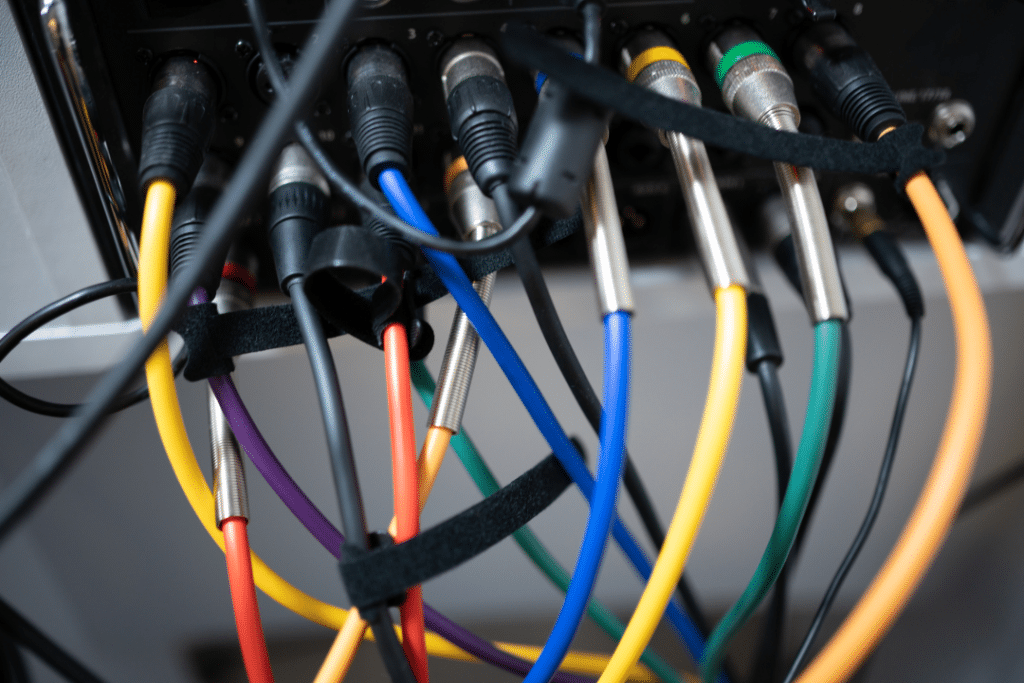
6. The Relationship Between Signal-to-Noise Ratio and the Noise Floor
The signal-to-noise ratio (SNR) is a fundamental concept in audio engineering that compares the level of the desired signal to the level of background noise. It quantifies the quality and clarity of an audio signal by expressing the ratio of the signal power to the noise power.
Calculating SNR and Its Interpretation
To calculate SNR when working with decibel measurements, subtract the noise level from the signal level: SNR = S – N. The difference between the signal and noise levels represents the SNR.
For example, consider a scenario where you measure a vocal track with a strength of 3 dB and a noise signal of -60 dB. By subtracting the noise level from the signal level (3 dB minus (-60 dB)), you obtain an SNR of 63 dB. This means that the signal power is 63 dB higher than the noise power, indicating a strong and clear signal in relation to the noise floor.
Importance of SNR in Audio Quality and Fidelity
SNR is crucial for maintaining high audio quality and fidelity. A higher SNR indicates a stronger and more distinguishable signal relative to the noise floor. This results in improved dynamic range, finer details, and enhanced clarity in the audio reproduction.
For instance, in a recording scenario, a higher SNR allows for capturing delicate sounds with minimal interference from the noise floor, preserving the original audio content accurately. During playback, a sufficient SNR ensures a faithful reproduction of the audio without introducing noticeable noise artifacts.
Understanding and optimizing the SNR helps achieve optimal audio quality and fidelity in various applications, ensuring a more enjoyable and immersive audio experience.
7. Noise Floor in Different Applications
In professional audio production, maintaining a low noise floor is imperative for delivering high-quality recordings and mixes. Noise floor requirements vary depending on the specific application and desired audio fidelity. In professional studios, where capturing pristine audio is paramount, it should be exceptionally low. This ensures that even the most delicate details are faithfully reproduced without being masked by background noise. High-end studios often aim for noise floor levels below -60 dB, allowing for superior signal clarity and dynamic range.
Noise Floor Considerations in Home Recording Setups
Home recording setups present unique challenges when it comes to managing the noise floor. These setups are typically located in non-professional acoustic environments, where background noise and suboptimal room treatments can be more prevalent. While achieving comparable levels to professional studios may be challenging, it’s still important to minimize unwanted noise.
Therefore, home recording enthusiasts should focus on optimizing their signal chain, employing noise reduction techniques during recording and mixing, and creating the quietest recording environment possible within their means. By reducing the noise floor to an acceptable level, home recordings can maintain a satisfactory level of audio quality.
Noise Floor Standards in Broadcast and Live Sound Environments
Broadcast and live sound environments have specific noise floor standards to ensure optimal audio transmission and delivery to the audience. Moreover, these standards often depend on the type of broadcast or event and the specific regulations in place. In broadcast environments, where clear speech and audio intelligibility are essential, noise floors are typically kept very low. This allows for pristine sound reproduction and minimizes distractions for the viewers or listeners.
In live sound scenarios, however, noise floor requirements may vary depending on the event, venue, and audience size. Striking a balance between reducing ambient noise and managing system noise is crucial to maintain an enjoyable live sound experience.
Final Thoughts
We hope this article has provided a comprehensive understanding of the noise floor and its significance in audio systems. By grasping the concept and considering its implications, you gain the ability to effectively manage and optimize the noise floor. This, in turn, helps you achieve superior audio quality in your endeavors.
11 Benefits of a WhisperRoom Sound BoothIn the world of audio recording and sound production, having a dedicated space that provides exceptional sound isolation is crucial. Our team specifically designs WhisperRoom sound booths to meet this requirement. Whether you are a musician, voice actor, podcaster, or audio engineer, WhisperRoom offers a range of unique benefits that can significantly enhance your recording experience.
In this blog post, we will explore the top 11 advantages of using a WhisperRoom sound booth.
1. Superior Sound Isolation
We build WhisperRooms with high-quality materials that effectively isolate sound, creating an environment free from external noise interference. The innovative design, specialized acoustic panels, and airtight seals ensure that WhisperRoom keeps unwanted sounds out, allowing you to achieve pristine audio recordings.
Whether you choose the Standard (Single-wall) or Enhanced (double-wall) unit, WhisperRoom’s commitment to sound isolation remains steadfast, providing you with a reliable solution to create a controlled recording environment. Additionally, you can easily upgrade all Standard (single-wall) models to Enhanced (double-wall) units, accommodating any future changes in your sound isolation requirements.
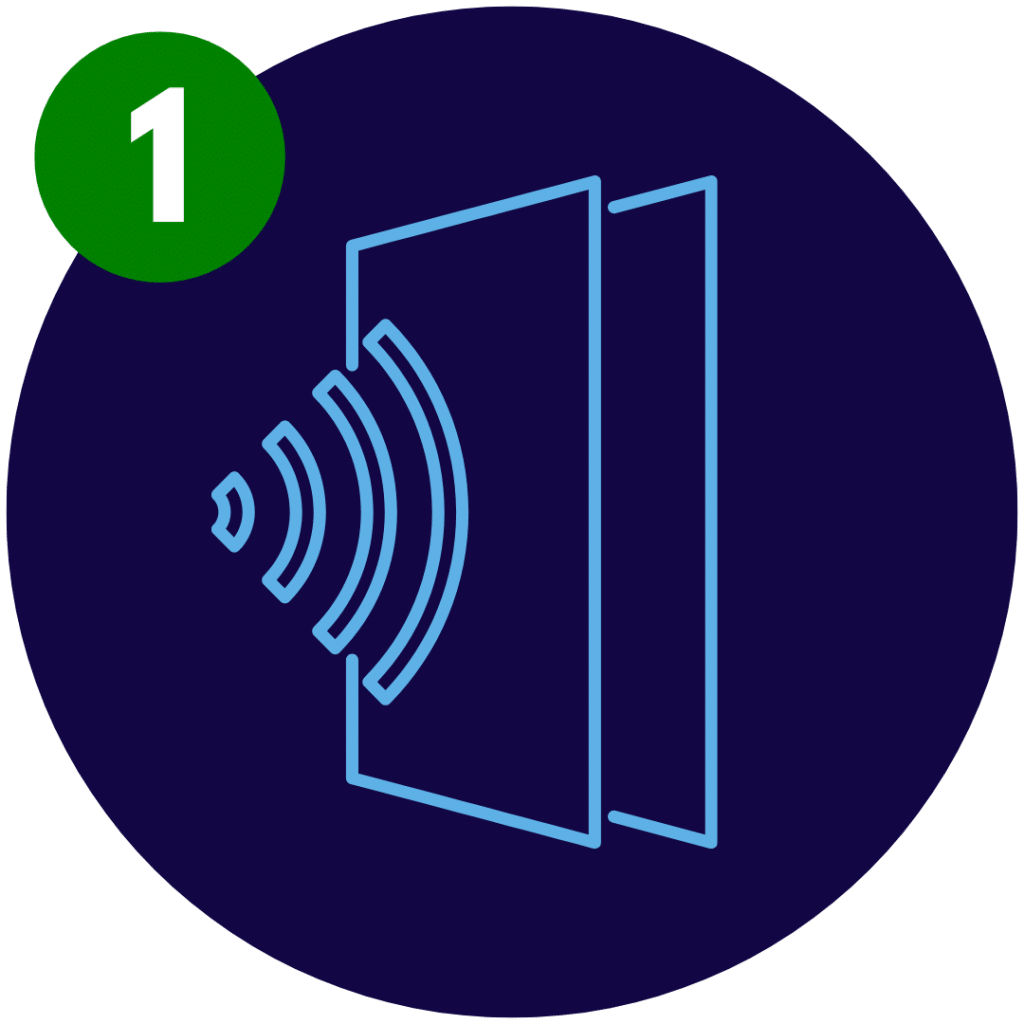
2. Customizable Design
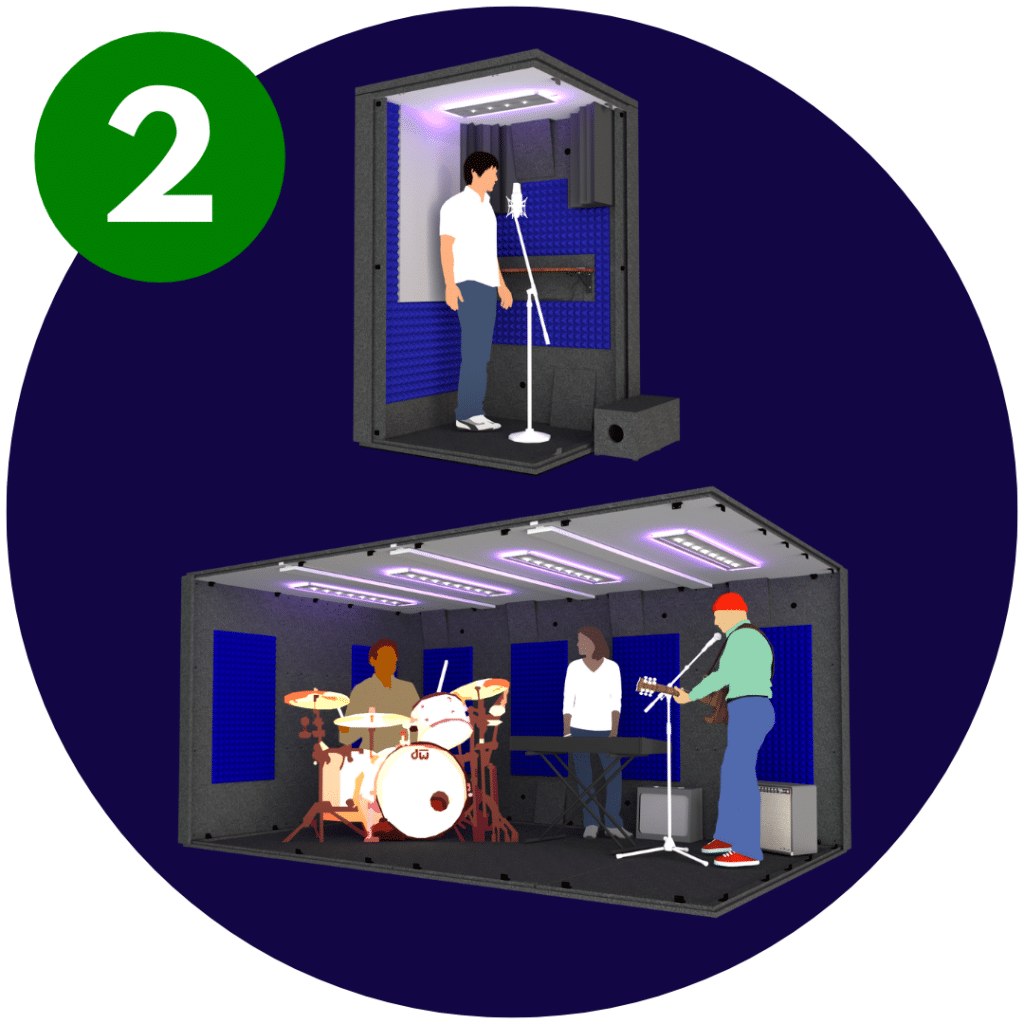
WhisperRoom offers a variety of booth sizes and customizable options to suit your specific needs. From compact single-person booths to larger multi-person configurations, you can choose the size and features that best fit your requirements. This flexibility allows you to create a tailored recording environment that maximizes your productivity and comfort.
3. Easy Installation
Setting up a WhisperRoom sound isolation booth is a breeze. We design the booths for easy assembly, providing detailed instructions, manufacturer support, and all the necessary tools for installation. With the help of another person, you can have your booth up and running in no time, saving you valuable time and effort.

4. Portability

One of the standout features of a WhisperRoom is its portability. Unlike traditional studio constructions, you can easily disassemble and relocate a WhisperRoom. This means that if you ever need to move your studio or upgrade to a larger space, you can take your WhisperRoom booth with you, preserving your investment and minimizing downtime.
5. Versatility
WhisperRoom sound isolation booths can accommodate multiple applications and do not have limitations to a single use. While people commonly use them in music recording and podcasting, WhisperRooms also excel in other areas such as voice-over work, audio post-production, broadcasting, audiology, scientific research, and more. The versatility of WhisperRoom booths makes them suitable for a wide range of professionals in various industries.
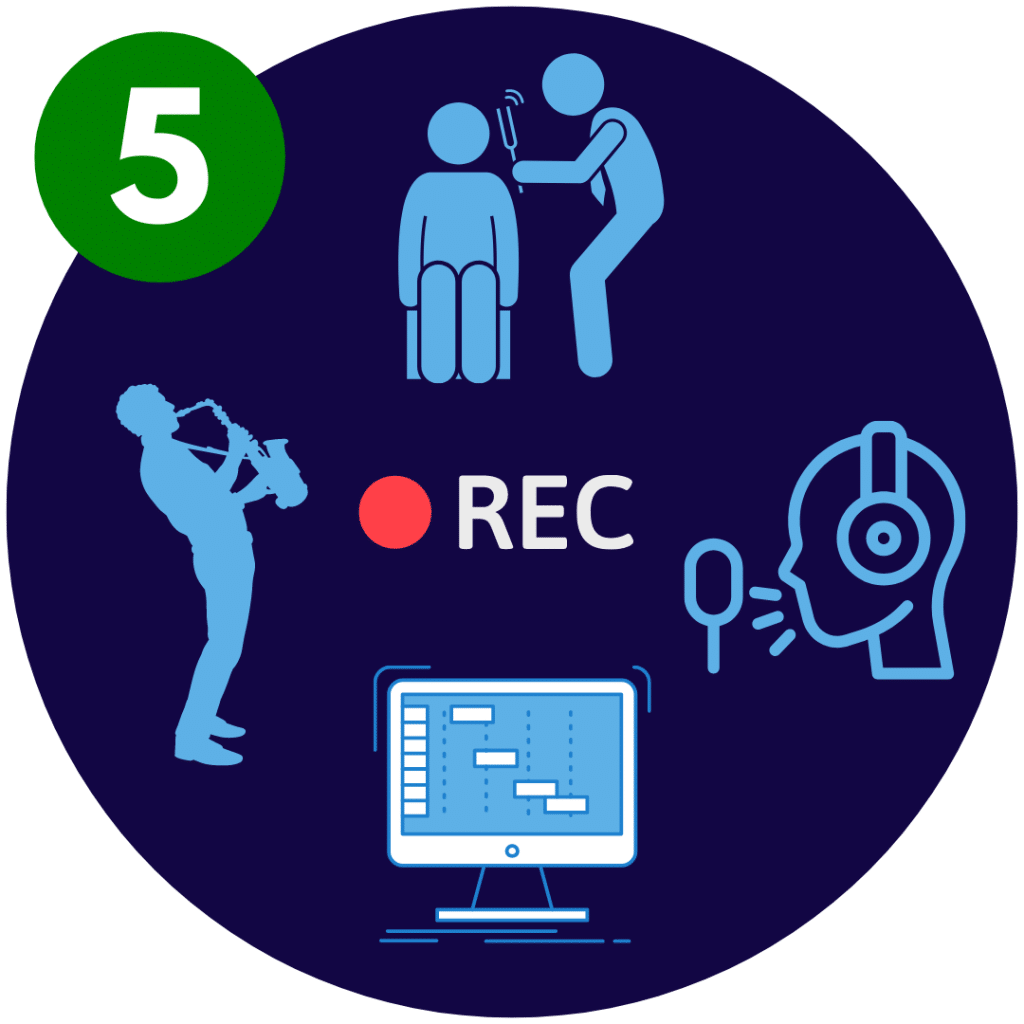
6. Excellent Acoustic Performance

WhisperRoom booths offer a range of interior acoustic treatment options, and each model comes with enough Auralex Studiofoam to cover approximately 1/3 of the booth’s interior. These specialized features effectively absorb sound reflections, reducing reverberation and echo, while eliminating unwanted room resonances. As a result, your recordings attain exceptional clarity, crispness, and overall audio quality, ensuring professional-grade audio productions.
Additionally, all the components of WhisperRoom booths are meticulously covered in a cloth-like material, contributing to the reduction of echoes and enhancing the overall acoustic performance. The fabric covering on the wall facilitates direct attachment of acoustic panels and other treatments using Velcro. This innovative feature enables you to securely affix acoustic panels to the booth’s interior (or exterior), ensuring optimal sound control. With the ability to fine-tune the acoustic characteristics of your recording environment according to your specific preferences, you can achieve desired audio outcomes and create an ideal space.
7. Controlled Environment
In addition to sound isolation, WhisperRoom booths offer precise control over environmental factors. You can equip the units with ventilation systems upgrades, HEPA Filter systems, and soundproof windows, enabling you to create a comfortable and controlled recording environment. This level of control ensures consistent results and optimal recording conditions that you can rely on every time.

8. Privacy and Confidentiality

For professionals dealing with sensitive or confidential content, privacy is of utmost importance. WhisperRoom sound isolation booths provide a secure and private space where you can work without the worry of sound leakage or unwanted interruptions. This makes them ideal for recording confidential voice-overs, dialogues, or any content that requires strict confidentiality.
9. Durability and Longevity
WhisperRoom booths are built to last. The high-quality construction materials and meticulous craftsmanship ensure their durability and longevity. We design our units to withstand the rigors of daily use, ensuring that they protect your investment for years to come.

10. Customer Support and Warranty

People know WhisperRoom for our excellent customer support and warranty. Should you have any questions or concerns, our knowledgeable team is readily available to assist you. Additionally, our limited 5-year warranty provides peace of mind, guaranteeing that your WhisperRoom booth is free from defects and will perform reliably.
11. Fast Turnaround Time
WhisperRoom understands the importance of timely delivery and efficient service. With a commitment to customer satisfaction, we keep all of our components in stock and are capable of shipping most orders within 48 hours of payment. This fast turnaround time ensures that you can quickly receive and start utilizing your WhisperRoom sound booth, minimizing any potential delays and allowing you to focus on your recording projects and other productive tasks without unnecessary wait times.

Have Questions?
Reach out to us at 800-200-8168 or email us at info@whisperroom.com. We are ready to assist you in building a functional quiet space that opens up endless possibilities.
Final Thoughts
Whether you’re a musician, voice actor, podcaster, or audio engineer, incorporating a WhisperRoom sound isolation booth into your setup can make a significant difference in achieving professional-grade audio productions. Experience the advantages of WhisperRoom and take your recordings to a new level.





